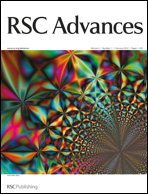Composite materials capable of recognizing enantiomers were prepared by coating a chiral selective layer in situ on a micro-porous polysulfone film through the interfacial polymerization of trans-1,4-diaminocyclohexane and trimesoyl chloride. The composition of the chiral selective composite materials were elucidated by FTIR (ATR mode) and their morphology was examined using scanning electron microscopy and atomic force microscopy. The functional performance of the composite materials was determined by measuring flux, rejection and enantioselectivity in the cross flow closed loop mode of reverse osmosis at 689.42 kPa pressure using a 1 g L−1 concentrated solution of racemic asparagine. The composite materials were permeated by the L-enantiomer of asparagine preferentially with over 72% enantiomeric excess. The concentrations of monomers in interfacial polymerization have a pronounced effect on the performance of the composite materials. Materials prepared from less concentrated solutions of trimesoyl chloride (1%) and trans-1,4-diaminocyclohexane (2%) exhibited higher solute rejection and low enantioselectivity, whereas materials prepared from more concentrated solutions of trans-1,4-diaminocyclohexane (6%) exhibited higher enantioselectivity and marginally lower solute rejection. The flux and rejection exhibited a positive time dependency, whereas enantioselectivity was independent of permeation time.

You have access to this article
 Please wait while we load your content...
Something went wrong. Try again?
Please wait while we load your content...
Something went wrong. Try again?


 Please wait while we load your content...
Please wait while we load your content...